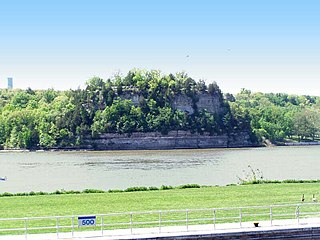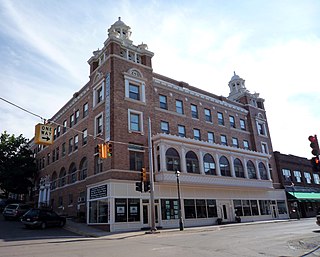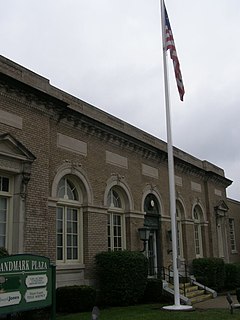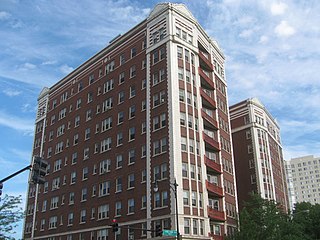
Hyde Park is the 41st of the 77 community areas of Chicago. It is located on the shore of Lake Michigan 7 miles (11 km) south of the Loop.

Starved Rock State Park is a state park in the U.S. state of Illinois, characterized by the many canyons within its 2,630 acres (1,064 ha). Located just southeast of the village of Utica, in Deer Park Township, LaSalle County, Illinois, along the south bank of the Illinois River, the park hosts over two million visitors annually, the most for any Illinois state park.

The Edgewater Beach Hotel was a resort hotel complex on Lake Michigan in the far-north neighborhood community of Edgewater in Chicago, Illinois, designed by Benjamin H. Marshall and Charles E. Fox. The first section was built in 1916 for its owners John Tobin Connery and James Patrick Connery, located between Sheridan Road and Lake Michigan at Berwyn Avenue. An adjacent south tower building was added in 1924. The resort hosted famous movie and sports stars, and later Martin Luther King Jr. It was also the setting for the celebrity stalking case and shooting that inspired the novel and movie The Natural. The hotel closed in 1967, and was soon after demolished.

The Belmont–Sheffield Trust and Savings Bank Building is a six-story building built in 1928 at 1001 W. Belmont Avenue, Chicago, Illinois. The building was designed by architect John Nyden and is on the National Register of Historical Places. It was constructed in a U-shape around a two-story central atrium, which allowed light to reach the bank lobby—the glass atrium has since been roofed over.

U.S. Route 66 was a United States Numbered Highway in Illinois that connected St. Louis, Missouri, and Chicago, Illinois. The historic Route 66, the Mother Road or Main Street of America, took long distance automobile travelers from Chicago to Southern California. The highway had previously been Illinois Route 4 (IL 4) and the road has now been largely replaced with Interstate 55 (I-55). Parts of the road still carry traffic and six separate portions of the roadbed have been listed on the National Register of Historic Places.
Sheridan Road is a major north-south street that leads from Diversey Parkway in Chicago, Illinois, north to the Illinois-Wisconsin border and beyond to Racine. Throughout most of its run, it is the easternmost north-south through street, closest to Lake Michigan. From Chicago, it passes through Chicago's wealthy lakeside North Shore suburbs, and then Waukegan and Zion, until it reaches the Illinois-Wisconsin state line in Winthrop Harbor. In Wisconsin, the road leads north through Pleasant Prairie and Kenosha, until it ends on the south side of Racine, in Mount Pleasant.

The Oregon Commercial Historic District is a historic district in Oregon, Illinois, that has been listed on the National Register of Historic Places since 2006. The district is roughly bordered by Jefferson, Franklin, 5th and 3rd Streets in Oregon. It is one of six Oregon sites listed on the National Register and one of three to be so listed since the turn of the 21st century. The other two are the Oregon Public Library, listed in 2003, and the Chana School, listed in 2005.

Pullman National Monument, also known as the Pullman District and Pullman Historic District, is located in Chicago and was the first model, planned industrial community in the United States. The district had its origins in the manufacturing plans and organization of the Pullman Company and became one of the most well-known company towns in the United States, as well as the scene of the violent 1894 Pullman strike. It was built for George Pullman as a place to produce the famous Pullman sleeping cars.

The Galena Historic District is a historic district located in the city of Galena, Illinois, USA. The historic district encompasses 85 percent of the city of Galena and includes more than 800 properties. The downtown area consists of three successive tiers made up of Main, Bench and Prospect Streets. Within the boundaries of the district are such notable homes as the Ulysses S. Grant Home and the Elihu B. Washburne House. The Galena Historic District was added to the U.S. National Register of Historic Places in 1969.

Indian Village Is the nickname given to the southeast portion of the Kenwood community area of Chicago, Illinois, United States. It is roughly bounded by Lake Shore Drive to the east Burnham Park to the north, 51st Street to the south, Harold Washington Park to the southeast, and the Illinois Central Railroad tracks used by the Metra's South Shore and Metra Electric Lines to the West. Many of the buildings in the neighborhood are named after Native American Indian tribes including the National Register of Historic Places-designated (NRHP) Narragansett and the Chicago Landmark Powhatan Apartments. Other buildings include several Algonquin Apartment buildings and the Chippewa.
Paul Taylor Powell was a Democratic politician from Illinois, and Illinois Secretary of State from 1965 until his death in 1970, after which he was discovered to have been corrupt and became known for his saying "There's only one thing worse than a defeated politician, and that's a broke one."

The Burtis–Kimball House Hotel and the Burtis Opera House were located in downtown Davenport, Iowa, United States. The hotel was listed on the National Register of Historic Places in 1979. It has since been torn down and it was delisted from the National Register in 2008. The theatre building has been significantly altered since a fire in the 1920s. Both, however, remain important to the history of the city of Davenport.

The Douglass House is a hotel located at the corner of Sheldon Avenue and Isle Royale Street in Houghton, Michigan. It was placed on the National Register of Historic Places in 1982.

The Old U.S. Post Office in Niles, Michigan is a Classical Revival building that was built in 1909. It was listed on the National Register of Historic Places in 1985.

The Promontory Apartments is a 22-story skyscraper in Hyde Park, Chicago, Illinois, United States designed by Ludwig Mies van der Rohe. It was the first skyscraper Mies designed and was the first of his buildings to feature concepts such as an exposed skeleton. The cooperative building overlooking Burnham Park has 122 units.

The architecture of Jacksonville is a combination of historic and modern styles reflecting the city's early position as a regional center of business. According to the National Trust for Historic Preservation, there are more buildings built before 1967 in Jacksonville than any other city in Florida, but it is also important to note that few structures in the city center predate the Great Fire of 1901. Numerous buildings in the city have held state height records, dating as far back as 1902, and last holding a record in 1981.

Hotel St. Benedict Flats is a historic apartment building located at the northeast corner of Chicago Avenue and Wabash Avenue in the Near North Side neighborhood of Chicago, Illinois. Built in 1882, the building was one of the "French flat" luxury apartments constructed after the Great Chicago Fire; named for their resemblance to Parisian apartments, these new buildings brought apartment living to Chicago's upper class. Architect James J. Egan, an Irish Catholic better known for his church designs, designed the Victorian Gothic building. The building's decorative features, such as its lintels, art glass windows, and use of pressed metal, were common features of contemporary upper-class homes, while its mansard roofs evoked French architecture. Egan named the building for the property's previous owners, the Order of Saint Benedict; the "Hotel" portion of the name was added to exploit a legal loophole, as the building never served as a hotel.

The East Park Towers are a historic apartment building at 5236-5252 S. Hyde Park Boulevard in the Hyde Park neighborhood of Chicago, Illinois. The building was constructed in 1922-23 during a period of residential growth in Hyde Park. While it had no guest rooms, the apartments offered similar amenities to an apartment hotel, such as housekeeping service. Apartment hotels were popular as part-time housing for wealthy workers, as they combined the amenities of in-home service with the affordability of apartments, and the East Park Towers were one of several such apartments built in Hyde Park at the time. Architect William P. Doerr designed the building in the Georgian Revival style; his design included terra cotta belt courses and quoins and Palladian windows on the first floor.

The Mayfair Apartments are a historic apartment hotel at 1650–1666 E. 56th Street in the Hyde Park neighborhood of Chicago, Illinois. Built in 1926, the building was part of a wave of residential department in Hyde Park, and it was one of several apartment hotels constructed there in the late 1910s and 1920s. Apartment hotels were popular among wealthy workers looking for part-time city housing, as they combined the amenities and prestige of a hotel with the price and location of apartments. The architecture firm Lowenberg & Lowenberg designed the building in the Georgian Revival style. The building's first three stories are clad with limestone and decorated with flat Corinthian columns and balustrades on the second-story windows. The remainder of the building is brick and includes a dentillated cornice at its roof and a second cornice above its eleventh story.



















